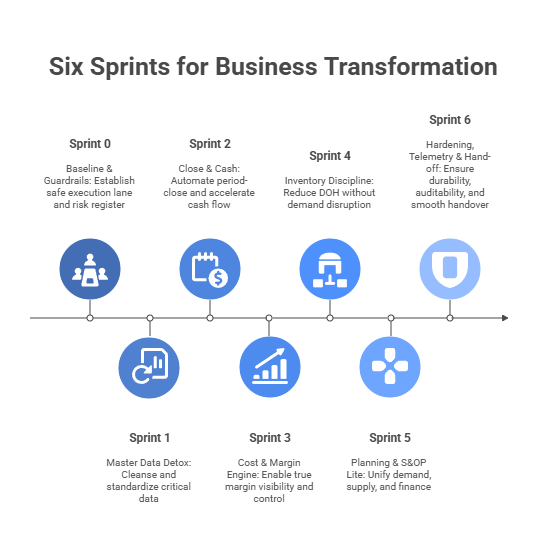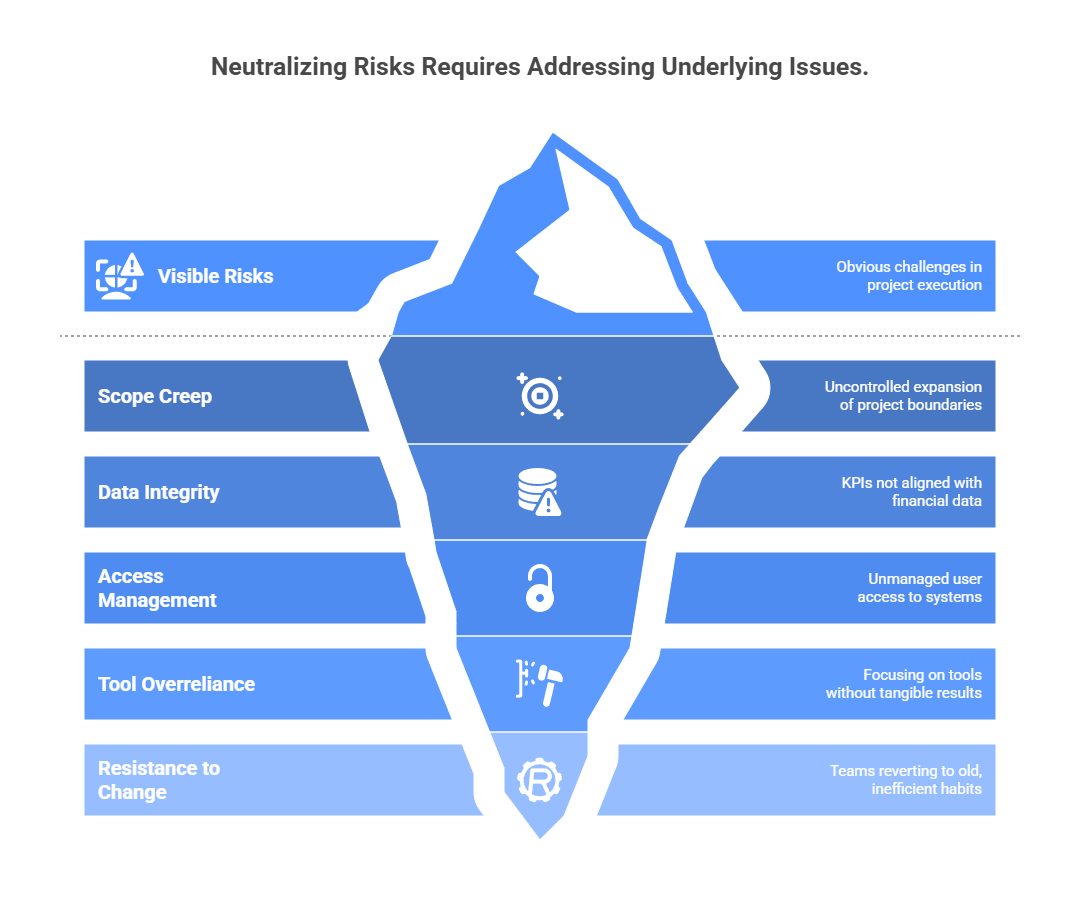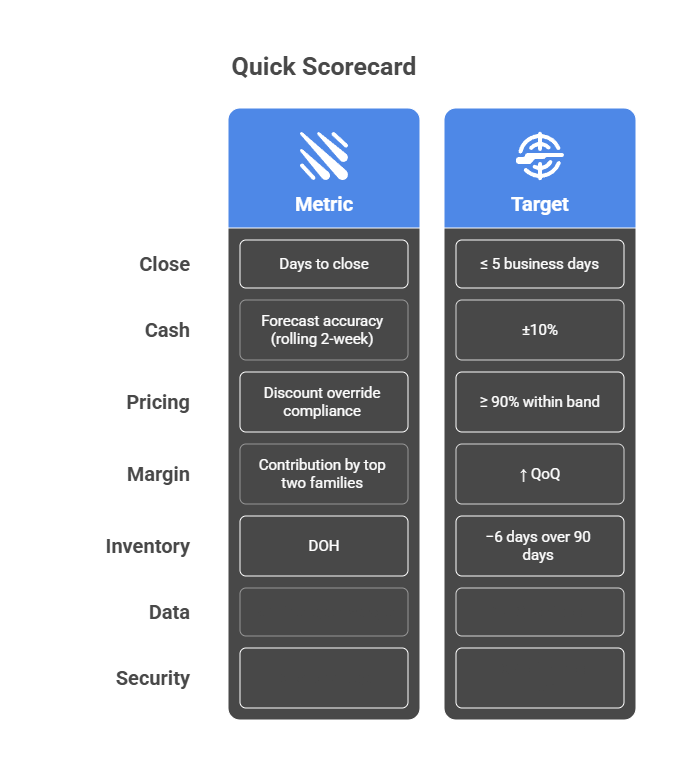ERP Modernization Without the Hangover: 6 Sprints That Stick
Oct 25, 2025
“Big-bang ERP” breaks mid-market momentum. The alternative is a sprint-based modernization that swaps monolithic go-lives for compounding wins: stabilize the data, harden the process, instrument the metrics, then phase in capability where it actually pays. Below is a six-sprint blueprint you can run with a small cross-functional team (Finance, Ops, IT, Commercial) without freezing the business.
Principles that keep you out of trouble
-
Business-first scope: tie each sprint to a P&L or balance-sheet outcome (margin, cash, close speed, OTIF).
-
Data over dogma: fix the master data and lineage before features; ugly data breaks elegant workflows.
-
Right-sized controls: enforce the few rules that matter (approvals, bands, access), don’t flood teams with policy.
-
Rehearse, don’t hope: simulate with real transactions before any cutover; keep a dated rollback plan.
-
Archive the truth: every sprint produces artifacts a buyer can re-run (scripts, lineage, test logs).

Sprint 0 — Baseline & Guardrails (2–3 weeks)
Objective: create a safe lane to execute sprints without business disruption.
Deliverables
-
Critical path map (Order-to-Cash, Procure-to-Pay, Record-to-Report) with owners.
-
Environment plan (prod, staging, sandboxes), access matrix, and change freeze windows.
-
“Truth set” for 12 months: reconciled extracts for Items, Customers, Vendors, GL, AR/AP, Inventory, BOM/Routings.
-
Cut decision list: which modules stay, which get wrapped, which get retired later.
Outcome: one page risk register; named approvers; rollback choreography.
Sprint 1 — Master Data Detox (3–4 weeks)
Objective: make the system trustworthy.
Moves
-
Customer/vendor canonical IDs; dedupe, merge rules, and address standardization.
-
Item and BOM hygiene: units of measure, pack sizes, revisions, cost fields; kill zombie SKUs.
-
Chart of accounts mapping: flatten gratuitous detail; lock posting rules.
-
Reference tables: payment terms, tax codes, freight rules, reason codes.
Artifacts
-
Data dictionary, match/merge scripts, exception logs, lineage diagram.
Metric lift: close time ↓; invoice errors ↓; inventory valuation adjustments ↓.
Sprint 2 — Close & Cash (3 weeks)
Objective: accelerate Record-to-Report and unlock cash.
Moves
-
Period-close checklist in the tool (not a spreadsheet) with owner, SLA, and sign-off.
-
AR: invoice timeliness automation; dispute reason codes; lock credit memo rules.
-
AP: approval paths by threshold; payment calendar aligned to 13-week cash.
-
Bank feeds and auto-reconciliation; daily cash position tile.
Artifacts
-
Close calendar with stamps; AR/AP policy cards; reconciliation scripts; variance reason code dictionary.
Metric lift: days to close ↓; DSO ↓; payment-on-term % ↑; forecast accuracy ↑.
Sprint 3 — Cost & Margin Engine (3–4 weeks)
Objective: see true margin, then steer it.
Moves
-
Standard/actual cost reconciliation with variance categories (price, yield, scrap, labor).
-
Cost-to-Serve drivers (pick lines, stops, handle time) wired to customers/channels.
-
Pricing bands in CPQ/quotes; approvals and overrides with expiry and reason codes.
-
SKU and customer contribution tiles for weekly commercial/ops huddles.
Artifacts
-
Cost model workbook; CTS driver map; CPQ export of rules; contribution by decile pack.
Metric lift: price realization ↑; contribution margin ↑; exception leakage ↓.
Sprint 4 — Inventory Discipline (3 weeks)
Objective: reduce DOH without starving demand.
Moves
-
ABC segmentation and service targets; safety stock rules by family.
-
SLOB program (aging thresholds, actions: markdown, bundle, refurb, scrap).
-
Purchase orchestration: MOQ alignment, supplier calendars, receiving appointments.
-
WMS hygiene: location accuracy, cycle counting, put-away rules.
Artifacts
-
ABC/service matrix; SLOB list with actions; buyer playbook; cycle-count results.
Metric lift: DOH ↓; slow-moving stock ↓; OTIF stable or ↑.
Sprint 5 — Planning & S&OP Lite (4 weeks)
Objective: unify demand, supply, and finance around one plan.
Moves
-
Demand plan from history + signals (promos, launches, seasonality); consensus flow.
-
Supply plan with constraints (capacity, lead time, yield) and finite scheduling where needed.
-
S&OP cadence: monthly executive meeting fed by weekly working sessions; decisions visible, time-boxed.
-
Scenario templates: base, upside, downside; impact on cash and covenant headroom.
Artifacts
-
Demand/supply templates; S&OP deck format; decision/exception log; scenario workbook.
Metric lift: forecast accuracy ↑; expedites ↓; overtime ↓; cash predictability ↑.
Sprint 6 — Hardening, Telemetry & Hand-off (2–3 weeks)
Objective: make improvements durable and auditable.
Moves
-
Observability: error logs, job runtimes, failed postings, and data drifts with alerts.
-
Access certifications (joiner–mover–leaver), MFA coverage, change logs.
-
Immutable monthly archive: KPI → financial tie-outs, scripts, and “rerun in 30 minutes” notes.
-
Handover: playbooks, runbooks, and a named owner per metric.
Artifacts
-
Observability dashboard; access inventory; archive index; runbooks.
Metric lift: incident MTTR ↓; audit exceptions ↓; KPI reproducibility = 100%.
What changes on Monday morning (operating rhythm)
-
Weekly ops huddle (30 min): price band exceptions, CTS hotspots, inventory actions, and cash tile—owners and decisions only.
-
Monthly S&OP (60 min): one plan, scenario deltas, and cross-functional trade-offs.
-
Quarterly audit (45 min): access review, lineage spot checks, and change log scan.
Risks & how you neutralize them

Buyer-grade proof (what goes in the data room)
-
12-month KPI → P&L reconciliation workbook with scripts.
-
CPQ pricing rules and exception logs, before/after price realization.
-
CTS model and policy outcomes tied to margin and OTIF.
-
Inventory health: DOH by family, SLOB actions with cash effects.
-
Close calendar, cash tile snapshots, and bank tie-outs.
-
Access inventory, change logs, and incident drill records.
Quick scorecard (track it every Friday)

VCII Note and Copyright
TVC Next treats ERP as an operating system upgrade, not an IT project. We sequence sprints on value rails (cash, margin, control), use data lineage to make numbers travel, and leave behind artifacts that buyers and lenders can re-run without ceremony.
Copyright © 2025 VCII, Meritrium Corp. All rights reserved.
We have many great affordable courses waiting for you!
Stay connected with news and updates!
Join our mailing list to receive the latest news and updates from our team.
Don't worry, your information will not be shared.
We hate SPAM. We will never sell your information, for any reason.


